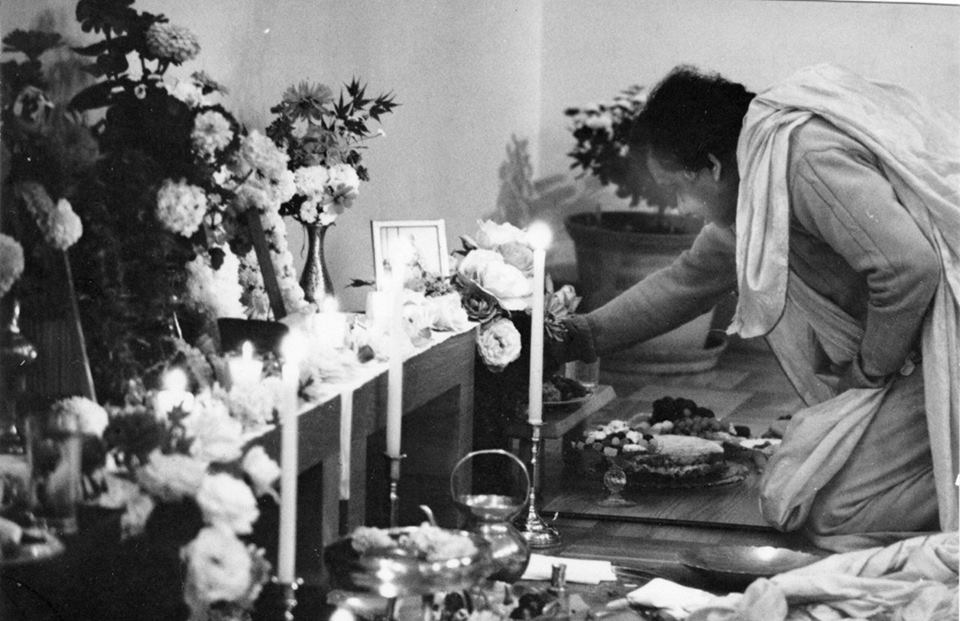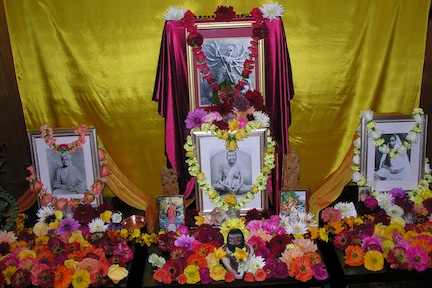Durga Puja – Some Reminiscences
 by Annapurna
by Annapurna
Durga Puja, the special autumn worship of the Divine Mother, is an important event for the SRV sangha in our annual cycle. It is a time when we “reset” our spiritual life and seek greater intensity, sincerity, and clarification in our personal sadhana through the power of devotion that comes from the Wisdom Mother. The Durga Puja offered each fall at our centers creates a palpable atmosphere of purification, sacrifice, austerity, wisdom, and deep devotion – all in a setting of exquisite beauty. [see 2014 dates]
In India, the autumnal worship of Mother Durga is called Navaratri, the Nine Nights. The lengthy, elaborate ceremonies continue for the full nine days, each day focusing on a special theme, from the “awakening” of the Deity in the image, to immersion of the image in the sacred river, symbolizing Mother’s inherent formlessness as the all-pervasive dynamic Intelligence saturating the three worlds.
 The late Swami Aseshanandaji Maharaj, minister of the Portland Vedanta Society, would hold this annual worship for one day. The lecture hall would be cleared of chairs so the devotees could sit on the floor, men and women sitting separately according to Indian tradition. There were two altars: one for puja and one for the homa ceremony. The puja altar held Mother Durga, Sri Ramakrishna, Holy Mother, and Swami Vivekananda, and also an image of Ganesha. Swami would invoke the presence of the Divine Mother at the altar through mantra and mudra. The monks of the Ramakrishna Order consider Holy Mother as the “Jonta Durga,” the Living Durga, as well as the Mother of the Order, and so there would always be an especial joy in this worship – “Mother has come!”
The late Swami Aseshanandaji Maharaj, minister of the Portland Vedanta Society, would hold this annual worship for one day. The lecture hall would be cleared of chairs so the devotees could sit on the floor, men and women sitting separately according to Indian tradition. There were two altars: one for puja and one for the homa ceremony. The puja altar held Mother Durga, Sri Ramakrishna, Holy Mother, and Swami Vivekananda, and also an image of Ganesha. Swami would invoke the presence of the Divine Mother at the altar through mantra and mudra. The monks of the Ramakrishna Order consider Holy Mother as the “Jonta Durga,” the Living Durga, as well as the Mother of the Order, and so there would always be an especial joy in this worship – “Mother has come!”
 Many would attend this special day. Sometimes Babaji and Loke Ma would be there from Hawaii and Swami would ask them to offer a devotional hymn. (Babaji once shared that one particular Navaratri, when just the initiates were attending arati in the shrine, Swami had everyone sign their names on paper in gold ink, thus surrendering themselves completely to the Divine Mother of the Universe.) Towards the end of the puja, all the devotees would line up and offer a single flower on a tray set before the altar. Only the pujari could put flowers on the altar. The tray overflowed by the end of the offering.
Many would attend this special day. Sometimes Babaji and Loke Ma would be there from Hawaii and Swami would ask them to offer a devotional hymn. (Babaji once shared that one particular Navaratri, when just the initiates were attending arati in the shrine, Swami had everyone sign their names on paper in gold ink, thus surrendering themselves completely to the Divine Mother of the Universe.) Towards the end of the puja, all the devotees would line up and offer a single flower on a tray set before the altar. Only the pujari could put flowers on the altar. The tray overflowed by the end of the offering.
After the puja, Swami would offer the homa (fire) ceremony, which took place inside the fireplace. This ritual is Vedic rather than Tantric like the puja. Sri Ramakrishna, as the personal God and the impersonal Reality, would be invoked in the fire with mantras, and then many symbolic items were offered into the flames. At the end, 108 trident-shaped leaves would be dipped in ghee and offered into the flames amidst the collective chanting of the mantra: Om sarva deva devi svarupaya Sri Ramakrishnaya namo namah! Then the ashes, mixed with ghee, would be collected, and Swami would use them to put a tilak on everyone’s forehead. The atmosphere was charged with the spirit of self-surrender and purification, for in the course of the puja, described above, we had surrendered ourselves to the Mother of the Universe, and in the homa, all impurities of the mind had been burnt in the flames.
 In the mid 1990’s, Babaji carried this tradition over to SRV Associations. Drawing from pujas described in the Srimad Devi Bhagavatam and the official worship of Sri Ramakrishna taught to him by Swami Damodarananda, Babaji composed a new authentic Durga Puja full of all the devotional depth and beauty of traditional puja, but also incorporating translations of the mantras and slokas from the Upanisads. This new style made the puja an accessible blend of devotion and wisdom, and also introduced many of us to the more esoteric aspects of the Goddess and Her forms, such as Lakshmi and Sarasvati. In it, Ganesha and the Guru (Master, Mother, and Swamiji) are each worshipped with great devotion as well. At the end of this three hour worship, which includes devotional songs and hymns, 108 flowers are offered to the Divine Mother with 108 of Her Holy Names, followed by an ecstatic arati using the five flame ghee lamp, ringing of bells, graceful chamara fan, and blowing of the sacred conches – all amidst joyous chanting: Om Sri Durga! Jai Sri Ramakrishna, Om Sri Sarada!, Jai Swamiji! Om Sri Kali! The puja complete, all the devotees receive from Babaji a red tilak on the forehead symbolizing the awakened Presence of the Mother in Her children, lighting our minds with Her own Intelligence.
In the mid 1990’s, Babaji carried this tradition over to SRV Associations. Drawing from pujas described in the Srimad Devi Bhagavatam and the official worship of Sri Ramakrishna taught to him by Swami Damodarananda, Babaji composed a new authentic Durga Puja full of all the devotional depth and beauty of traditional puja, but also incorporating translations of the mantras and slokas from the Upanisads. This new style made the puja an accessible blend of devotion and wisdom, and also introduced many of us to the more esoteric aspects of the Goddess and Her forms, such as Lakshmi and Sarasvati. In it, Ganesha and the Guru (Master, Mother, and Swamiji) are each worshipped with great devotion as well. At the end of this three hour worship, which includes devotional songs and hymns, 108 flowers are offered to the Divine Mother with 108 of Her Holy Names, followed by an ecstatic arati using the five flame ghee lamp, ringing of bells, graceful chamara fan, and blowing of the sacred conches – all amidst joyous chanting: Om Sri Durga! Jai Sri Ramakrishna, Om Sri Sarada!, Jai Swamiji! Om Sri Kali! The puja complete, all the devotees receive from Babaji a red tilak on the forehead symbolizing the awakened Presence of the Mother in Her children, lighting our minds with Her own Intelligence.
The first time Babaji offered this new Durga Puja probably occurred in October, 1997. In preparation, he had memorized the entire puja – three hours’ worth of purificatory mantras, Upanisadic verses, and hymns in Sanskrit and English. Earlier, a retreat had been held in Hawaii during the previous summer, and we had gone on an outing to “Millionaire’s Pool,” a warm pond heated by volcanic activity. Babaji went missing for a very long time, and when he finally reappeared, lying in the pool and looking peaceful and indrawn, we learned he had been mentally performing the puja for the entire time as he floated on the warm waters. On the flight over to the mainland to the centers that October, he also described how he mentally performed the entire puja throughout the flight. He said that the puja happened in his dreamstate too.
In the following years, he would describe, by way of teaching, how the intense focus of performing puja inwardly is a sure and certain way to banish all fear, and raise one’s consciousness at the approach of difficulties, during illness, and death. It also became a way of conveying how to withdraw the mind from the external world and enter “the kingdoms of heaven within.” Around this time, Babaji also began to teach Tantra philosophy, along with his ongoing classes of Vedanta, Yoga, and Sankhya. One of the Seven Victories of Tantra, called manojavittvam, the attainment by which the concentrated mind is instantly present anywhere at the speed of thought, was sometimes explained via this memorization of the puja, its movements and mudras. Upon placing one’s mind there, one would swiftly shift levels of awareness.
Intense preparation by the sangha preceded this first Durga Puja. No one but Babaji knew what it would be like. A group of us collected hundreds of flowers and arranged them on trays. Copper and brass vessels and trays were polished. We gathered bits of grass, tiny flower buds, ghee wicks, essential oils, lumps of incense resin, rice, vessels of various kinds. We made kum kum and sandal paste, and set aside a sari, a chuddar, a large beautiful leaf, and glasses of water, sweets, fruits and nuts. All was in readiness and we sat in anticipation before the altar. Babaji’s steps could be heard walking from his room down the hall. He entered and made a full prostration before the altar. Every motion felt purposeful and one-pointed. He began the first purifications of the pujari’s body and senses. Then I saw him trace a yantra over what would be the space of the pujari’s seat. I was not then familiar with yantras or what they meant, and did not yet know that, as the Tantras say, “Only God can worship God,” and that the purpose of the purifications of the pujari’s body and now the seat, was to make of oneself a pure vehicle, even an emanation, of the Devi, the Goddess. I remember wondering what purpose could “really” be served by “drawing” a triangle, a square, and a circle on the carpet. In the back of my mind was sitting the “doubter of ritual.” But then, Babaji sat in that seat, and the effect was like turning the tumblers in a lock. The energy shifted and I, and probably everyone else, were “locked” into the next three hours with all potential for distraction destroyed, and lifted into a divine realm of beauty, glory, power, wisdom, and burgeoning love.
